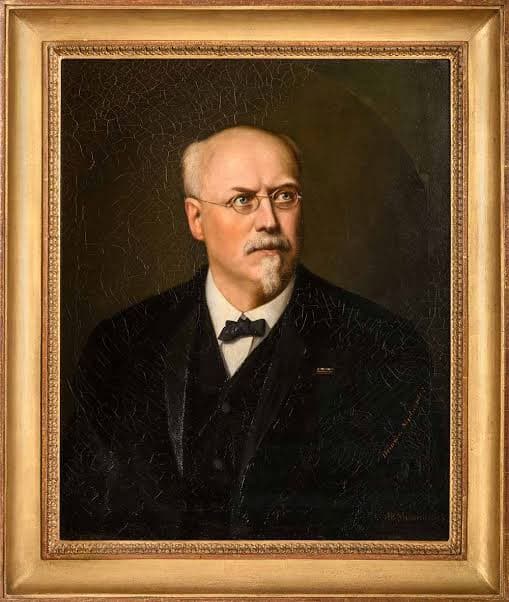Swiss composer Joachim Raff (1822–1882) is barely known today, and if you do remember him, it’s most probably in relation to Liszt. While Liszt was in Weimar, Raff was his assistant for a while and was responsible for the orchestration of Liszt’s first tone poems. As a composer, he was introduced to music by his father, an organist and teacher for whom he was also his copyist. His first career was as a teacher in primary school – aside from his father’s teaching, the rest of his musical training was done on his own. Learning the piano, organ, and violin.

Joachim Raff
While teaching in a primary school in Rapperswill, he made friends with a Kapellmeister in Zürich, Franz Abt, who encouraged his compositions. In 1844, his first music pieces were published on the recommendation of Mendelssohn, and then reviewed favourably by Schumann in the Neue Zeitschrift für Musik. With that encouragement, he quit his day job, moved to Zürich, and tried to earn his living through his music. This wasn’t working very well until he met Liszt’s secretary Gaetano Belloni in Basel. Belloni introduced him to Liszt and this went well, with Liszt, then in the middle of a concert tour, inviting Raff to accompany him on the tour. From Zürich, they went to Strasburg, Bonn, and Cologne, where Liszt got him a job in a music shop. Raff next moved to Stuttgart, where he met Hans von Bülow, and from there, with the help of Liszt, he moved to Hamburg to work as an arranger for a publisher and then, in 1850, joined Liszt in Weimar. This peripatetic lifestyle finally grew old, and in 1856, he left Liszt, married Doris Genast, and moved to Wiesbaden, where he established himself as a composer and musician of importance. In 1877, he moved to Frankfort, where he was appointed director of the Hoch Conservatory, where he remained until his death.
Raff’s symphonic works cover 12 symphonies, of which the first is now lost. His 8th symphony, The Sounds of Spring, is a lovely introduction to the music of a confident master. His Spring Symphony is more developed and thoughtful than we hear from someone like Mendelssohn, particularly in the second movement.
We open in the last days of winter, at first oppressive, then brightening with an optimistic dancing song.
Joachim Raff: Symphony No. 8 in A Major, Op. 205, “Frühlingsklänge” (Sounds of Spring) – I. Frühlings Rückkehr (Spring’s Return): Allegro (Slovak State Philharmonic Orchestra, Košice; Urs Schneider, cond.)
The second movement, set during Walpurgis night, scurries in the darkness. Saint Walpurga was the saint you invoked against ‘pest, rabies, and whooping cough, as well as against witchcraft’, and throughout Europe, Saint Walpurga’s Eve (or Walpurgisnacht) was held on the night of 30 April to May 1. The night is celebrated by lit bonfires, celebrating the canonization of Saint Walpurga and the removal of her relics to Eichstätt, both of which happened on 1 May 870.
May 1 is, of course, an auspicious day, being the day of the ancient festival marking the beginning of summer, i.e., halfway between the spring equinox and the summer solstice. Along with gathering flowers and dancing around the maypole during the day, bonfires are part of the night celebration. Over time, the ancient May Day and the medieval Walpurgis celebrators combined.
Joachim Raff: Symphony No. 8 in A Major, Op. 205, “Frühlingsklänge” (Sounds of Spring) – II. In der Walpurgisnacht (During Walpurgis Night): Allegro (Slovak State Philharmonic Orchestra, Košice; Urs Schneider, cond.)
When the first flowers of spring appear, young men’s hearts turn to love, and so Raff uses the slow movement, a Larghetto, to spin a beautiful song of love.
Joachim Raff: Symphony No. 8 in A Major, Op. 205, “Frühlingsklänge” (Sounds of Spring) – III. Mit dem ersten Blumenstrauß (With the First Bunch of Flowers): Larghetto (Slovak State Philharmonic Orchestra, Košice; Urs Schneider, cond.)
The last movement gathers up all the urgency of spring and sends us on the road to new adventures.
Joachim Raff: Symphony No. 8 in A Major, Op. 205, “Frühlingsklänge” (Sounds of Spring) – IV. Wanderlust: Vivace (Slovak State Philharmonic Orchestra, Košice; Urs Schneider, cond.)
Raff’s next symphonies took up the other seasons: Symphony No. 9 is summer, Symphony No. 10 is Autumn, and Symphony No. 11, his last, is Winter. It was left unfinished at his death and was completed by Max Erdmannsdörfer, a German conductor, pianist, and composer who was the dedicatee of Raff’s works for piano ensemble.
For more of the best in classical music, sign up for our E-Newsletter
